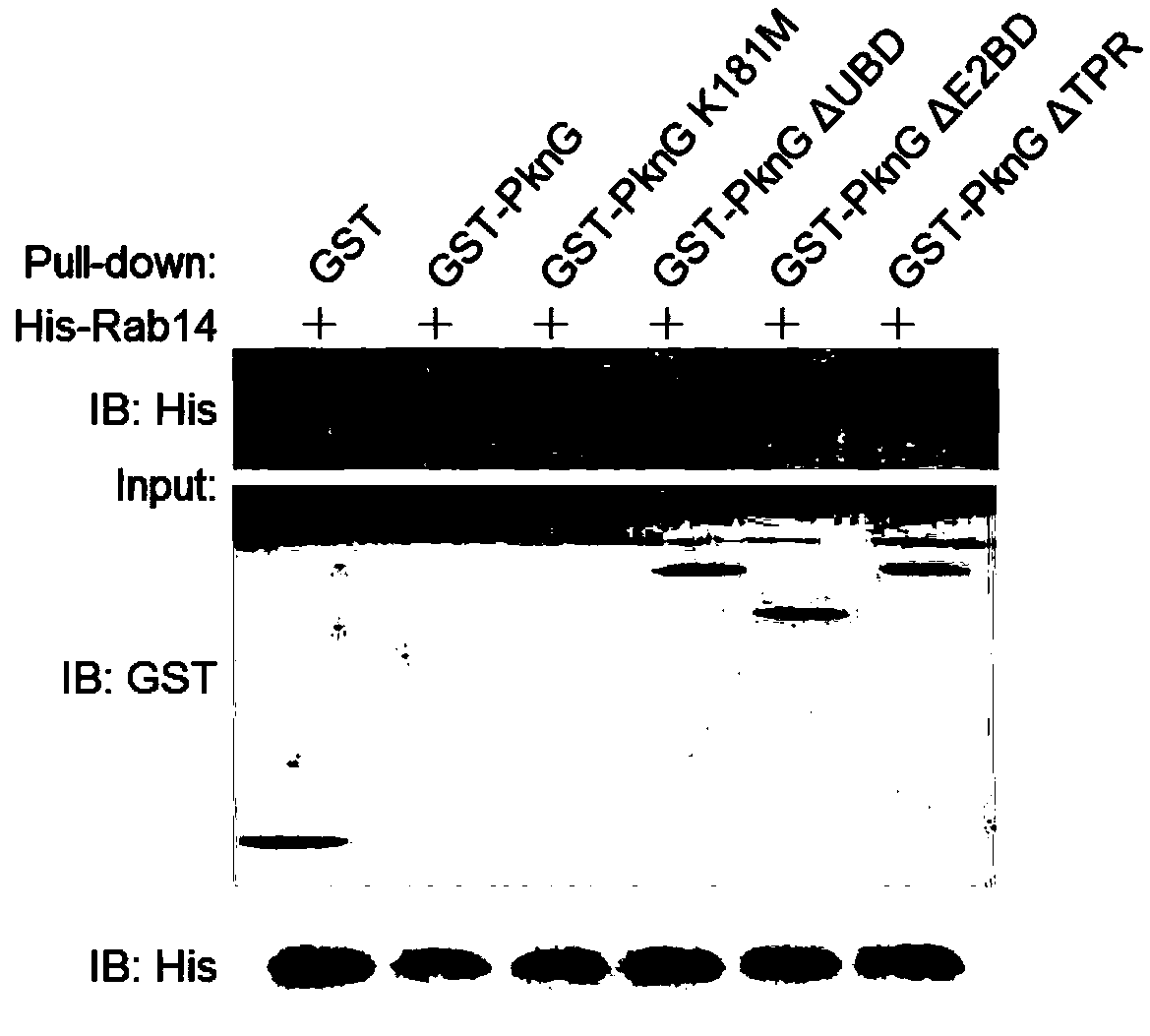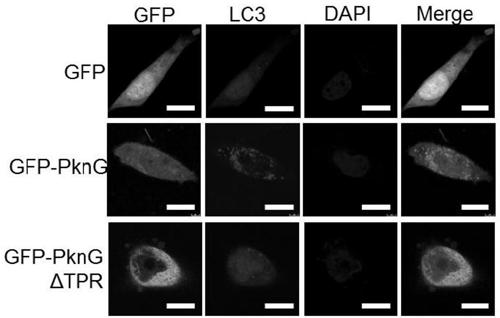Target for resisting mycobacterium tuberculosis and applications thereof
A Mycobacterium tuberculosis, domain technology, applied in medical preparations containing active ingredients, antibacterial drugs, peptide/protein components, etc., can solve the problems of unclear specific molecular mechanism, decreased viability, etc. effect, inhibition of intracellular survival
- Summary
- Abstract
- Description
- Claims
- Application Information
AI Technical Summary
Problems solved by technology
Method used
Image
Examples
Embodiment 1
[0021] Example 1 The TPR domain of the Mycobacterium tuberculosis secretory protein PknG
[0022] Through bioinformatics analysis, it was found that the conserved TPR domain (amino acid sequence shown in SEQ ID NO: 1) that exists in eukaryotic proteins also exists in the 506th amino acid sequence of Mycobacterium tuberculosis effector protein PknG (GI: 15607551) -568, but its function is not clear. Studies have found that PknG can inhibit the autophagy flow of cells and promote the intracellular survival process of Mycobacterium tuberculosis through the interaction between the TPR domain and host proteins Rab14 (Gene ID: 612673), Akt (Gene ID: 207). The sequence of the pknG gene is shown in GeneID:886397.
Embodiment 2
[0023] Example 2 PknG interacts with Akt and Rab14 through the TPR domain
[0024] The preparation method of the PknG TPR domain protein in the examples: construct the gene encoding PknG or its truncated body on the pGEX-6P-1 plasmid, construct the Akt and Rab14 genes on pET30a respectively, and then transform the plasmids into the large intestine In Bacillus BL21, use IPTG to induce protein expression at 30°C; ultrasonically break the bacteria, and collect the supernatant after high-speed centrifugation; slowly flow the supernatant through the packed Glutathione-Sepharose beads (GE), and then add it to the column Wash the column fully with washing buffer, and finally add 2-3ml of eluent to elute the protein; add the collected eluate to a 10KD protein concentration tube (millipore), and concentrate by centrifugation at 3500rpm for 20 minutes; add 2ml of PBS to the protein concentration tube Mix well and centrifuge; aliquot the protein and store at -80°C until use.
[0025] GS...
Embodiment 3
[0026] Example 3 PknG promotes autophagy by interacting with Akt
[0027] The PknG gene encoding PknG and the PknG gene encoding the deletion of the TPR domain were respectively constructed on pEGFP-N1 plasmids; the recombinant plasmids were transfected into HeLa cells laid on coverslips with Lipofectamine 2000 (Invitrogen, Carlsbad, CA), and simultaneously transfected The pEGFP-N1 empty vector was used as a control; after 6 hours of transfection, replace the fresh DMEM medium containing 10% FBS to continue the culture; after 24 hours of culture, discard the medium, wash the cells twice with PBS, and then fix the cells with 4% paraformaldehyde 10min, wash the cells three times with PBS, permeate the cells with 0.5% Triton X-100 for 10min, wash the cells three times with PBS, block the cells with 1% BSA for 30min; Incubate with Alexa594 red fluorescent secondary antibody for 1 h at room temperature, then wash the cells three times with PBS and seal with a mounting medium contai...
PUM
 Login to view more
Login to view more Abstract
Description
Claims
Application Information
 Login to view more
Login to view more - R&D Engineer
- R&D Manager
- IP Professional
- Industry Leading Data Capabilities
- Powerful AI technology
- Patent DNA Extraction
Browse by: Latest US Patents, China's latest patents, Technical Efficacy Thesaurus, Application Domain, Technology Topic.
© 2024 PatSnap. All rights reserved.Legal|Privacy policy|Modern Slavery Act Transparency Statement|Sitemap



